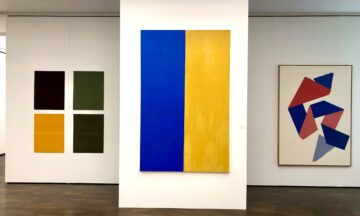Franz Erhard Walther's participative sculptures and installations from the 1960s onwards can be classified as Process Art. In his oeuvre, Walther combines a basic exploration of the notion of sculpture with an accentuation of its origination process. Although his works are reminiscent of Minimalism in their simplicity and reduced form, Walther's approach is different. He regards his objects as working material that can be used to trigger fundamental experiences. For Walther, that means questions of self-definition, of orientation, and of the formation of consciousness. The viewers enter into an active dialogue with the works through so-called 'work actions', which alters the traditional concept of viewer and work and leads to an "other concept of the work (of art)" (Walther).
Walther took part in documenta four times and attained international recognition with his innovative approach to the notion of the work of art. As early as 1969, he exhibited his famous 'First Work Set' at the Museum of Modern Art in New York. This was an interactive installation comprised of 58 objects made of the most diverse materials; they were to be 'used' by the viewers, for instance by opening objects, lying down inside them, or turning them into geometric forms. Other important groups of works include the 'Second Work Set' started in 1969, with 'Advancing Elements' and 'Standing and Advancing Elements', as well as the 'Wall Formations' from 1979 on, and the 'Action Tracks' in the 1990s.
![Franz Erhard Walther - Die Formen sind im Kopf 1/4 Franz Erhard Walther - Die Formen sind im Kopf 1/4]()
![Franz Erhard Walther - Die Formen sind im Kopf 1/3 Franz Erhard Walther - Die Formen sind im Kopf 1/3]()
![Franz Erhard Walther - Die Formen sind im Kopf 1/4 Franz Erhard Walther - Die Formen sind im Kopf 1/4]()
![Franz Erhard Walther - Die Formen sind im Kopf 1/4 Franz Erhard Walther - Die Formen sind im Kopf 1/4]()
![Franz Erhard Walther - Die Formen sind im Kopf 1/14 Franz Erhard Walther - Die Formen sind im Kopf 1/14]()






